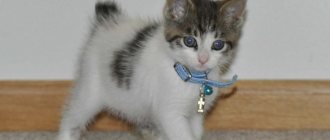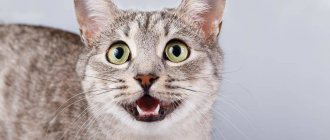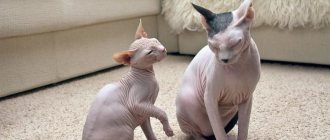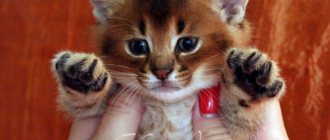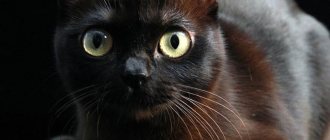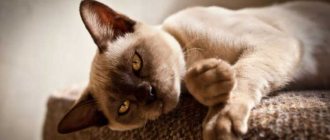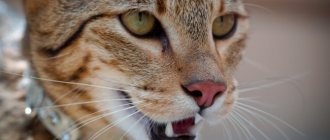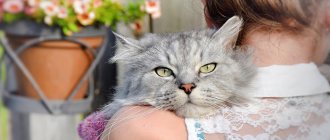Description of the Burmese cat breed
The description of the above breed includes several characteristics and qualities that the animal must fully comply with.
Dimensions and weight of the Burmese cat
When you look at a Burmese cat, you get the impression that it is a very light, almost weightless, medium-sized animal. But as soon as you take her in your arms, you immediately understand your mistake. So, an adult cat of this breed can weigh about 9 kilograms, and a female cat can weigh about 6 kilograms. It’s not for nothing that the popular phrase “a brick wrapped in silk” is used to describe the Burmese breed.
If we consider the weight of the Burmese by month, we get the following picture:
| Age | Male | Female |
| 1 month | From 450 to 750 grams | From 300 to 500 grams |
| 3 months | From 1.5 to 2.4 kg | From 1.2 to 1.7 kg |
| 6 months | From 3 to 5.7 kg | From 2.5 to 3.6 kg |
| 1 year | From 6 to 7.5 kg | From 3.5 to 5.4 kg |
| 2 years | From 8 to 9 kg | From 4 to 6 kg |
Advice for future owners
The described disadvantages and advantages cannot be perceived unambiguously. It all depends on the needs of the future owner. If the decision to own a Burmese has already been made, several recommendations will be useful to owners:
- If the absence of owners in the house is inevitable, you can get a second cat , which will become a companion for the Burmese.
- If a cat of this breed is not acquired for breeding, it is worth sterilizing . Your veterinarian will advise you about the appropriate age for this operation.
- You need to be prepared for hooligan antics . Prepare the apartment by removing valuable and fragile items.
- Despite the excellent health of the Burmese, we must not forget about vaccinations, regular visits to the veterinarian and proper nutrition.
For some, the Burmese's sociability will be a disadvantage of the breed. If a family wants to get a cat to decorate the sofa, then this beauty is definitely not suitable
Knowing about the characteristics of the Burmese beauty, all that remains is to understand your desires and capabilities. If the future owner is ready to share his attention and time with the cat, then the Burmese breed will come in handy. You need to understand that this smart girl will fight for the right to become a member of the family. And be sure to think carefully about whether you want to expand your family in this way.
Burmese standard
- Build: Muscular, strong, incredibly well-built, medium size. Males are always larger and heavier than females. The chest is quite powerful, which gives the impression of the strength of the Burmese cat. The back is equal.
- Coat: thick, short, without undercoat, very soft and pleasant to the touch, dense.
- Head: rounded, muzzle short with an elongated forehead, wide cheekbones.
- Neck: strong, thin and long.
- Eyes: large, very expressive, round in shape. They shimmer in all shades of yellow (from honey to amber) and green. Moreover, the older the Burmese cat is, the lighter the color of its eyes becomes.
- Ears: beautiful triangular shape, slightly rounded tips.
- Limbs: ideally proportional to the body, medium size. The paws are neat with fairly developed muscles. This cat breed has five toes on the forelimbs and four on the hind limbs.
- Tail: Medium length, slightly tapering towards the tip.
Burmilla nutritional features
Due to their predisposition to kidney disease, Burmilla's require special nutrition. Make sure your cat is getting enough fluids, but not drinking too much. Excessive moisture puts a strain on the urinary system and can cause an exacerbation of hereditary pathology. It is better not to give too many soups or broths. The nutrient content of a daily dose of food should be approximately as follows:
- proteins - 12%;
- fats - 3.3%;
- minerals - 2%;
- fiber - 1.3%.
When choosing ready-made food, give preference to those whose packaging is marked “Helps maintain the health of the urinary system.” Make sure the food you choose contains vitamin D3, iron, iodine, copper, manganese, zinc and calcium. Suitable Burmillas are:
- RC Instinctive (in pate form);
- Prescription Diet Kidney Care (dry food);
- RC Indoor 27 (dry food);
- RC Urinary Cary (pieces of meat in sauce).
Burmillas need to be given special food that supports the functioning of their urinary system.
If a cat is diagnosed with hereditary polycystic disease in the chronic stage, then he will need phosphate binders (calcium carbonate or calcium citrate). They are found in renal foods, for example, Farmina Vet Life, Hill's Prescription Diet K/D Feline Renal Health, Purina Veterinary Diets NF, Eukanuba Renal. Weakened kidneys cannot properly remove phosphorus from the blood. This leads to the fact that the level of this substance in the body becomes too high, it begins to “take away” calcium, and the risk of osteoporosis increases. Sometimes there is a deficiency of sodium and magnesium, which can be compensated for with the help of vitamin supplements.
Colors of Burmese cats
The color of Burmese cats also has its own characteristics. Thus, the European type of this breed is allowed to have almost any color without stripes or spots. But the American type is allowed to have only four colors:
- Sable. It is a rich chocolate shade that becomes darker on the face, paws and tail.
- Blue. This color can be either uniform or slightly darkened on the tail and muzzle.
- Champagne. Its color is a little reminiscent of coffee with milk, but it becomes darker on the paws, nose, tail, and ears.
- Platinum. It is also called lilac. It's a beautiful shade of creamy color that deepens on the face.
The difference between the American Burmese and the European
Today there are two types of Burmese breed: American and European.
The European Burmese are distinguished by greater “refinement”. It has less weight and a more elongated body. The muscles are noticeably weaker. But the limbs are longer and slimmer. The eyes can be described as almond-shaped, which gives cats a stern look.
The American Burmese cat is heavier. It has a round head and muzzle, and the eyes are also round, which gives them a good-natured and even somewhat naive look. In addition, the ears of this type are slightly rounded.
Character and habits
The Burmese cat is an ideal choice for those who are looking for a kind, affectionate, cheerful and loyal animal. The Burmese is incredibly active; even older cats of this breed take great pleasure in chasing sunbeams and flies.
Representatives of the Burmese are often called “cats with the soul of a dog.” Because they simply love to spend time with their owner, to participate in every moment of his life. Therefore, do not be surprised that it will be difficult to drive such a cat off your lap; it will follow you everywhere, and at night it will crawl under the blanket to sleep closer to the person.
An interesting feature: Burmese cats love all family members absolutely equally, but cats choose only one, who will become her favorite. Also, representatives of this breed very sensitively sense the mood of the owner and adapt well to it.
Compatible with children and other pets
Burmese cats get along well and get along well with other animals, be it dogs or parrots.
They also have wonderful relationships with children. Adults can rest assured that representatives of this breed will not scratch or hiss at children; on the contrary, they will happily take part in their games.
The cats I want to talk about are the miracle cat Seyla and the miracle cat Ginny. It is difficult to find more voluminous words, because my Burmese cats are truly the decoration of our home and the joy of our life. And it is miracles that decorate our lives.
The first wonderful kitten appeared at our house in the spring of 2000, and it was also almost a miracle. After all, before I knew absolutely nothing about the Burmese breed. The desire to have a cat has been brewing for a long time. But after the death of my British girlfriend Linda, I couldn’t decide on this for a long time. It took 5 long years until the pain subsided, and the absence of an animal in the house became unbearable.
First, we finally got a dog - a small Chinese dog named Larik. But this was a concession to my daughter, and it seems that this did not reassure me. Every day I realized more and more that I wanted a CAT, because I was born a real “cat lady”.
My ardent desire was supported, and we began to select a breed. I didn't want to take an ordinary kitten. I wanted to know the date of birth of my pet, and his parents, and to know “how” he was born, and to see his “baby” photographs. I wanted to know everything about him, which means he had to be a “child with a passport.” The breed was the hardest to choose. After all, in books about pedigree cats they write almost the same way - kind, affectionate, clean, not capricious, etc. And in life it turns out that the Persians are sleepyheads, the sphinxes are sometimes aggressive, the British are independent. Something loomed in my head - a really affectionate, not at all aggressive, unpretentious, definitely short-haired, definitely omnivorous and not capricious cat. Yes, so that she would also be cheerful, and playful, and would greet me at the door like a dog... That’s what she wanted, you say. Is there such a thing? Or maybe this is from the realm of fantasy?
I understood that miracles do not happen, but I continued to look for a sample that would be as close as possible to the fantastic ideal. First, we read all the books available for sale, then “cat” magazines, and scoured the Internet. Something was emerging, but I felt it was not mine. I started calling breeders and learned about cats first-hand. One day, one breeder, a very nice woman, told me: “I consider the most promising cats to be the Bengal, Abyssinian and Burmese cats.” Stop, stop! I myself have already thought about Bengals and Abyssinians, but I don’t know anything about Burmese. It was then that my heart “sank” and told me that I was on the right path. She rushed to the books again. That's it! There was practically no information about Burmese cats. Cats, so popular in both Europe and America, were “closed” to Russia for a long time. I collected information about the Burmese bit by bit. With every step it became clearer - this is the cat I am looking for. The last straw was an article in a book by a Czech author that I accidentally bought, where I found my “ideal cat image.” She was a Burmese - a cat with a thousand characters, strong, healthy, an ideal companion, affectionate, playful, perfectly trainable, unpretentious, long-lived, who is always waiting for her owner to give him all her love.
So, the choice has been made, all that remains is to find the cat itself, or rather the kitten. It was not so easy at the beginning of 2000! I was lucky - at that time there was only one litter in Moscow and there were two little girls in it. Why a cat and not a cat? I always wanted to have kids. The kitten will grow up quickly, and I love these little fluffies so much. Another reason why an elite cat, and not a “backyard” cat. You can’t find a home for the kittens of a yard cat, but kittens with a pedigree will always find homes. In addition, I will be sure that the kittens will receive decent upbringing and care. It’s no secret that “ordinary” cats often fall out of windows, get hit by cars, and become victims of yard and non-yard dogs. And the owners take care of kittens with a passport. That’s just how people are - they don’t take care of what they get for free. The kitten that has been “bought” will receive the best nutrition, the best care, and, if necessary, good medical care.
I was very lucky with the breeder. She turned out to be an absolutely charming woman who is doing a lot of work to popularize Burmese women in Russia, Elena M. Surinova. For her, cats are individuals, and each cat is a living miracle. E. Surinova showed us all her cats, told us about each one, about their history, about the history of the breed, about the colors. She showed books with beautiful photographs and photographs of cats from her cattery. We were fascinated by all the cats, and of course both girls. The choice was difficult, since both girls were gay and very similar. One way or another, from the minute I picked one of them up, a miracle happened. My soul became “Burmese”.
Oh, I got this Burmese little devil! I have never had such energetic cats. Jumping, flying, acrobatic performances with turns in the air, somersaults over the head and God knows what else! And at the same time, again, a miracle - not a single broken vase or plate. My Seyla reminded me of a flying squirrel that flies somewhere above us, and we only have time to see her huge, enthusiastic eyes. And how much tenderness everyone’s favorite gave us! The Burmese is truly a cat-dog. Whenever I come home from work, she patiently waits for me at the door along with Larik. And moments of tenderness immediately begin - right into your arms, with a collar around your neck, purring in your ear, squeezing and unclenching your claws in happiness.
I have never had problems with feeding, since Burmese are omnivorous and a little gluttonous. I don't mind, because a good appetite is a sign of excellent health. This is probably why the Burmese have such a smooth, silky coat. A healthy, varied diet helps maintain excellent body condition. Because of its short, silky coat, the Burmese is also called the “brick wrapped in silk.”
My pussy just doesn’t know how to scratch and bite. Even when I wash her before exhibitions, she patiently endures the unpleasant procedure. By the way, about exhibitions. At first I didn’t even think about an exhibition career. Elena Mikhailovna practically persuaded me to go to our first exhibition. But our first success changed my whole soul. It was so nice! We probably also rejoice at the success of our children. After the first exhibition, I realized that I had become a “careerist”, because without a successful career, the life of both the cat and the owner is completely uninteresting. Now my Seile has one show left - and she is a big international champion. By the way, it is more difficult for cats to have a “career” than for cats. After all, during the breaks between exhibitions, the cat must still perform its main function of “mother cat”. And how wonderful it is that sometimes these wonderful little creatures appear in my apartment, who can rush around my body in a bunch, as if on a football field, with their tails shaking with delight!
The matter did not end with Seila alone. It was only later that I heard that Burmese people tend to “accumulate” in the house. And this is no coincidence. These cats are really easy to keep at home in large numbers even in a small area. And the love of one Burmese cat eventually becomes not enough. This does not mean that cats become less affectionate with age. Quite the opposite! It’s just that their love evokes such a huge reciprocal feeling in our hearts that it’s already too much for one favorite. This is how Seyla’s sister, the chocolate turtle Ginny, appeared in my house. She is a year and a half younger than Seyla, and has been living with us for six months now.
Ginny's appearance was the second miracle, completely different from the first. This second miracle is even more devilishly seductive. Its spontaneity evokes both delight and bewilderment at the same time. We call her a democratic cat. Ginny does not like restrictions on her own freedoms at all. Her resistance is limitless! However, like a true Burmese, she never lets out her claws. But there is plenty of screaming and impulses from the powerful body. The only exception is the procedure for trimming nails before exhibitions. This is where the morals of both cats change dramatically. Seyla silently tries to break free, begging for mercy with her huge eyes. Ginny lies on her back, with her outstretched, tense paws spread out in different directions, and, without making a single attempt to escape from the clutches of the “executioner,” periodically screams heart-rendingly. Tears and laughter with these devils!
As much as Burmese kittens are active, adult cats are just as calm. Now I find it hard to believe that my elegant, graceful, majestic Seyla was once an impetuous kitten jumping over my head. Although Burmese women retain their playfulness until the end of their days. As soon as I wave a string with a paper bow in front of her, the miracle kitten wakes up inside her again. The same jumps and pirouettes, the same somersaults and turns. After all, the Burmese are born hunters. And everything that moves is already prey. That’s why my cats are so interested in the African mice and rats that live with us. Keeping watch near the cages is a favorite pastime. It is useless to explain to Burmese women that these mice are also family members. These fluffies are very interesting, and they smell so delicious!
My dog Larik also had problems for the first day or two. And hissing, and fur standing on end, and a paw on the dog’s face... And then - in an embrace on a dog bed. Sometimes they offend you - they both lie down in a ball on the bed, and the dog next to them is sad. But Larik is a gentleman and always gives the best seats to the ladies.
Burmese cats get along well with children. If a child accidentally hurts a cat, it will not hit him with a paw with sharp claws, but will simply turn away and run away. The Burmese woman does not remember the insult; very soon she will return back to be tender and purr.
These cats have enough love for everyone. And although it is believed that they love someone in the family more, we do not notice this. In the evening, when we climb under the warm blankets, our cats begin to “migrate” from one bed to another. On each one you need to lie down, grumble, rub your cheek, warm the sore spots. The round continues throughout the night. I go to bed - Seyla is on me, I wake up - Ginny is on me. They do not like the cat corner specially purchased for them; they need a person, his warmth and attention.
When I come home from work in the evening and open the door, I always see the same picture - two cats and a dog sitting at the door, waiting for me. To take off my shoes, I bend over, and immediately both of my favorites jump on my back and occupy my shoulders. So each one sits on “her” shoulder until they pour out all the affection accumulated during the day on me. And it’s quite difficult to throw them off. They fought long and hard for the right to “love” me on my shoulders, and, it seems, they won.
Recently I wondered why two of my close friends have the last names Burdonskaya and Burmistrova? Burma - this word should have been on my tongue, but I didn’t notice. It was probably a special sign, and in the end what was destined to happen happened. A miracle happened, although they say that miracles do not happen. And in our house now miracles happen every day.
Lyudmila SENCHENKO
Care and maintenance
Caring for Burmese cats is quite simple, but it requires regularity and time from the owner. To begin with, you need to buy your little pet a cozy bed, toys and a good scratching post.
What to feed the Burmese
Special attention should be paid to feeding the Burmese cat. So, it is better to purchase premium dry food. They contain those minerals and vitamins that allow the Burmese to maintain its majestic appearance, and its coat to shine and shimmer in the sun. In addition, feeding representatives of this breed the same thing will also not work. Dry food needs to be diluted with other food. For example, lean chicken, turkey, veal or rabbit. You can give your Burmese cat vegetables and ready-made cereals, once a week - an egg, boiled sea fish, fermented milk products (low-fat).
Please note that a small kitten (up to five months) should be fed four times a day, a slightly older kitten (up to eight months) should be fed three times, and a completely adult cat should be fed twice a day so that your pet does not gain excess weight .
Wool
Despite the fact that the Burmese cat's fur is not long, it needs to be carefully looked after. So, once a week you need to comb it with a special rubber brush; if your pet sheds, then you should comb it twice. If you want to give Burmese wool a special shine and shine, you can rub it with silk.
You can bathe a Burmese cat no more than once every five months.
Caring for ears, eyes and other body parts
Due to the fact that Burmese cats have a special structure of tear ducts, it is important to wipe your pet’s eyes, and in some cases it is better to use hygienic veterinary drops for this. It is better to clean your ears with a special lotion. Burmese cats also need to be vaccinated regularly. Trim nails once or twice a month.
Walking your pet
The Burmese cat has a fairly calm disposition, so you can either keep it in an apartment or let it go outside. But in any case, it is better to walk the animal under control. For these purposes, it would be good to purchase a leash.
How to choose the right kitten
To be sure that the animal is purebred, it is recommended to buy it from a specialized nursery or from a reliable breeder. Before making a transaction, it is advisable to make sure that the Burmese kitten has documents confirming its breed and vaccinations.
It is also advisable to observe children in their familiar environment. This will help to partially identify the main features of their character and form at least a superficial idea of their state of health.
Burmese kittens should be playful, active and moderately curious. Their appearance must meet the official standard. And there should be no white spots on the fur.
Kitten care
Conscientious breeders separate offspring from their mother no earlier than three months of age. Thanks to this, Burmese cats reach their new owners fully vaccinated and quite independent.
These babies can use the litter box without any problems, know how to use a scratching post, and can eat many foods. Therefore, new owners will not have to teach them basic things. You just need to give him time to get used to the changed conditions and show him where the bowls, toilet and place to sleep are located.
To prevent the Burmese kitten from becoming a victim of its own curiosity, wires, household chemicals, indoor plants and fragile objects are hidden from it. Also, for safety reasons, before turning on the washing machine or oven, be sure to check if there is a small pet inside.
To prevent the Burmese from developing digestive problems due to the stress of the move, at first she is fed what the breeder recommended. New foods are introduced into the diet of a kitten of this breed in stages to monitor the body’s reaction.
The feeding schedule is based on the age of the Burmese:
- 3-4 months – 5 times a day;
- 4-7 months – 4 times a day;
- 8-11 months – 3 times a day.
A one-year-old Burmese cat can get by with two feedings a day.
Breeding Burmese cats
The first mating of Burmese cats is best done at two years of age (although the first heat occurs as early as six months). It will be good if the female lives in the male’s territory for several days. A cat's pregnancy lasts 72 days, during which time she becomes especially affectionate and calm. It is also necessary to agree in advance with the specialist who will attend the birth. Kittens are usually born strong and healthy.
Diseases
Burmilla's health is quite good. Timely vaccinations will help avoid serious diseases in the future. Many cat owners think that if their pet does not leave the house, then they do not need vaccination. However, it is not. Germs can appear at home and through dirty shoes, and the animal will get sick without direct contact with the infection.
The first vaccinations for Burmilla kittens are given at the age of 3 months, after performing anthelmintic procedures.
These animals suffer from diseases inherited from chinchilla cats and from Burmese cats.
These diseases include polycystic kidney disease. Your cat is urinating frequently. The disease can cause kidney failure in the animal. They do not have other genetic diseases.
They are prone to obesity; poor quality food can cause problems with the blood vessels of the heart.
History of the Burmese cat breed
The ancient state of Burma (today it is called Myanmar) in Southeast Asia is considered to be the birthplace of Burmese cats. The first mention of these animals was found in manuscripts of the 12th century, and medieval books even contain their images.
It is believed that Burmese cats lived at temples, and accordingly, they were equated with sacred animals. The monks took care and patronage of them in every possible way, thus demonstrating their respect and veneration for the gods. It was the Burmese cats that accompanied the deceased to the afterlife, protecting his peace. Also, according to legend, it was these animals that brought wealth and good luck to their owner, so royal and aristocratic families tried to get themselves a Burmese cat. Foreigners could receive them only as a gift for great devotion. At that time, the animal had a beautiful sable color.
It was only in the 19th century that Burmese cats first came to Britain, known as Black Siamese. Modern Burmese owe their appearance to the doctor Joseph Thompson, who in 1920 brought a small kitten named Wong Meow to America and began crossing him with Siamese. As a result, back in 1938, a breed with an incredible chocolate color appeared. In the same year, she was presented to the attention of felinologists and registered. After World War II, the Burmese breed was developed with an amazing tortoiseshell and cream coloration. And then cats of this breed spread throughout the world.
Health
The Burmese cat may suffer from several diseases, so regular care and examination by a veterinarian is required. This breed is prone to diabetes, they can develop partial or complete blindness, and there is a possibility of congenital deformation of the skull. In addition, Burmese suffer from gingivitis, acute respiratory infections and hypokalemia.
Gingivitis
Some individuals suffer from gingivitis - inflammation of the gums, which manifests itself in the appearance of purulent seals. The cause of the disease is considered to be hormonal imbalance, caries, damage from sharp bones, vitamin deficiency, and intestinal infections. The most common reason is poor teeth cleaning.
Treatment is simple: most often it is enough to change the food, wipe the gums with a special solution, and take a course of vitamins. In some cases, antibiotics may be prescribed. The best prevention is regular brushing of your pet's teeth. If you don’t know how to do this yourself, contact a veterinary clinic.
acute respiratory infections
Heat-loving Burmese cannot tolerate cold, and their immunity may not cope with low temperatures and drafts. Most individuals are susceptible to respiratory diseases. Cats suffer from watery eyes and runny nose. If you notice minor discharge from the eyes or nose, wipe it away, but if this happens more often and your cat becomes lethargic, it’s most likely time to see a doctor.
Disease prevention is simple: maintain your pet's immunity with high-quality food and vitamins, regularly visit the veterinarian and get vaccinated.
Hypokalemia
Some Burmese cats are susceptible to hypokalemia, a condition in which the level of potassium in the blood is low. Animals continue to live with this disease, but if the level drops too low, the pet feels unwell and is unable to even stand up.
The disease is transmitted genetically and can be detected at an early age. Such animals are sold at a lower price and most often with the condition of mandatory castration.

